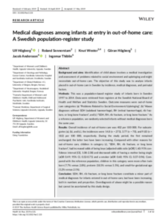Displaying 751 - 760 of 2214
This paper explores how the principle of linked lives can illuminate our understanding of how relationships positively influence the educational journeys of adults with care experience over time.
This paper explores how the principle of linked lives can illuminate our understanding of how relationships positively influence the educational journeys of adults with care experience over time.
This open access article reports on a qualitative study, which sought to retrospectively understand the contribution family group conferencing (FGC) makes to longer‐term outcomes for children at risk of entering State care and their families.
In this paper, the authors describe a process used to inform the development of a parenting intervention that would have high relevance to child welfare involved parents and could then work towards proving its effectiveness.
This article compares and contrasts the services needed by families in child welfare systems with the services that families receive.
Therapeutic Interventions with Babies and Young Children in Care is about the value of observation and close attention for babies and young children who may be vulnerable to psychological and attachment difficulties.
The objective of this open access study was to analyse infants placed in out‐of‐home care in Sweden by incidence, medical diagnoses, and perinatal factors.
Drawing from focus groups with Therapeutic Foster Care (TFC) foster parents, this paper explores different aspects of their experiences, identifies multiple ways in which they need support, and provides recommendations for foster care agencies looking to retain skilled foster parents and increase the quality and stability of children's experience in TFC programs.
This paper explores foster carers’ therapeutic capacities and considers some key implications for fostering agencies.
The current study provides an in-depth examination of the psychometric properties of the “Your Life, Your Care” survey which measured the subjective well-being (SWB) of children and young people in out of home care (OHC) in England and Wales.

